According to legend, the Shwedagon Pagoda was constructed more than 2,600 years ago, which would make it the oldest Buddhist stupa in the world. Currently scholarly research by historians and archaeologists indicate that the pagoda was first built between the 6th and 10th centuries AD.
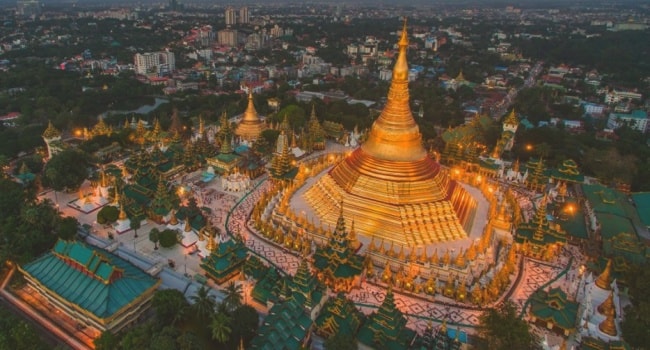
Epic Guide for the Golden Temple of Shwedagon Pagoda
 Jolie LIEM
Jolie LIEM
 27/12/2025
27/12/2025
No visit to the Union of Myanmar is complete without a visit to the 2,500 years old Shwedagon Pagoda, which enshrines strands of Buddha's hair and other holy relics. Located west of the Royal Lake on 114 -acre Singuttara Hill in Yangon, Shwedagon Pagoda is the most sacred and impressive Buddhist site for the people of the Union of Myanmar. From a humble beginning of 8.2 meters, the Shwedagon Pagoda today stands close to 110 meters.
Shwedagon Pagoda is covered with hundreds of gold plates and the top of the stupa is encrusted with 4531 diamonds; the largest of which is a 72-carat diamond. It is clearly one of the wonders of the religious world. Shwedagon Pagoda is a repository of the best in Myanmar heritage – architecture, sculpture and arts. The Shwedagon Pagoda consists hundreds colorful temples, stupas, and statues that reflects the architectural era spanning almost 2,500 years.
To understand this monumental work of art and architecture, visitors will experience an insider's view of this magnificent symbol of Buddhism to the lives of the Myanmar people. Shwedagon Pagoda forms the focus of religious as well as community activities – the bustling of devotees and monks washing the statues, offering flowers, worshiping, and meditating. Shwedagon Pagoda is administered by the Board of Trustees of Shwedagon Pagoda.
- The Legend of Shwedagon Pagoda
- The design of Shwedagon Pagoda
- Shwedagon Pagoda’s Rituals
- Shwedagon Pagoda Festival
- Shwedagon in literature
- War and invasion
- Political area
- Replicas of Shwedagon Pagoda
- A guide for visiting Shwedagon Pagoda
- The facts of Shwedagon Pagoda
- Visiting Information
- Shwedagon Pagoda Gallery
- Hotels near Shwedagon Pagoda
- FAQs about Shwedagon Pogoda
The Legend of Shwedagon Pagoda
The beginning
The tradition concerning the founding of the Shwedagon, as contained in the Hmannan Mahayazawindawgyi (The Great Glass Palace Chronicle) which was compiled in the early 1830s by a Royal Commission composed of learned monks, brahmins and lay scholars, goes thus:
According to Buddhist history, over 2500 years ago, PrinceSiddartha had just attained Buddhahood, after the realization of the "Four Noble Truth" which are
- Life means suffering.
- The origin of suffering is attachment.
- The cessation of suffering is attainable.
- The path to the cessation of suffering.
Tapussa and Bhallika, two merchant brothers of Asitanjana which was in the Mon country, went on a trading journey by ship and by 500 carts.
They arrived at the place where the Lord Buddha sat in the bliss of emancipation under the linlun tree. It was the 49th day after his Enlightenment and the two brothers offered him honey cakes.
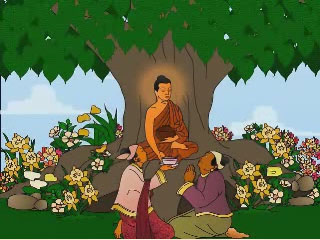
After the Lord Buddha had eaten the cakes, the two brothers asked for a gift from him. The Lord Buddha passed his hand over his head and, obtaining eigth hairs, gave them to the brothers. The sacred hair were eight fingerbreadths long in the Majjhimadesa (Indian) measure.
The two brothers then returned as they had come, by carts and by ship, carrying the sacred hairs with them in a ruby casket. On the way, they met with the King of Ajjhatta, who requested and received from them two of the sacred hairs. As they travelled by ship and reached Cape Negraisat the southwestern extremity of Myanmar, a Naga (Serpent) King named Jayasena obtained two more sacred hairs from them and carried them to the naga country of Bhumintara
The two brothers then placed the ruby casket containing the remaining four sacred hairs in a pile of pearls shaped like a pagoda and informed the King of Ukkalapa of the matter. The King came with the four arms of war - elephants, horses, chariots and foot soldiers - and, making a vow, paid reverence by making a clockwise circuit of the pagoda of pearls. Through his vow, the sacred hairs were restored to their original number of eight.
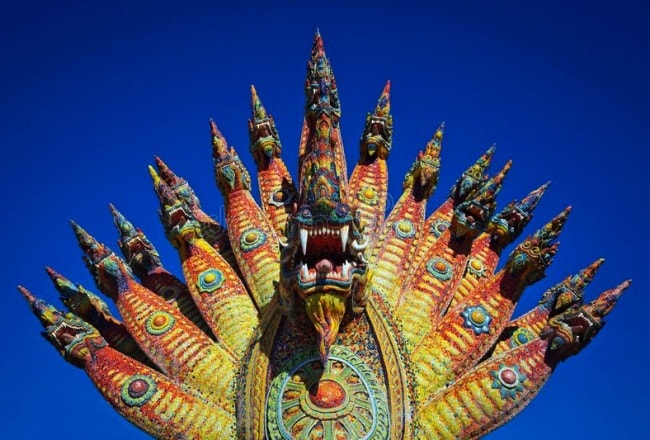
The King and the two brothers then brought the sacred hairs back to Asitanjana. At Asitanjana, Sakka, King of Devas, the King of Ukkalapa and the two brothers decided to enshrine the eight sacred hairs on Singuttara Hill to the east of Asitanjana where also were enshrined the relics of the three Buddhas previous to Gotama - the water filter of Kakusandha, the robe of Konagamana and the staff of Kassapa.
The enshrinement took place on the Full Moon day of Tabaung, a Wednesday. Sakka, the King of Ukkalapa and the two brothers made a relic chamber 44 cubits square and 44 cubits deep. The relic chamber was filled knee-deep with jewels of all kinds; on these was placed a jewelled ship, and on the jewelled ship, the relics of the four Buddhas.
A stone slab all covered with gold was placed over the relic chamber and on it was erected a golden pagoda 44 cubits high. The golden pagoda was encased in a silver pagoda, then in a pagoda of gold and copper alloy, then in bronze pagoda, then in iron pagoda, then in a marble pagoda, and finally in a brick pagoda
A stone slab all covered with gold was placed over the relic chamber and on it was erected a golden pagoda 44 cubits high. The golden pagoda was encased in a silver pagoda, then in a pagoda of gold and copper alloy, then in bronze pagoda, then in iron pagoda, then in a marble pagoda, and finally in a brick pagoda.
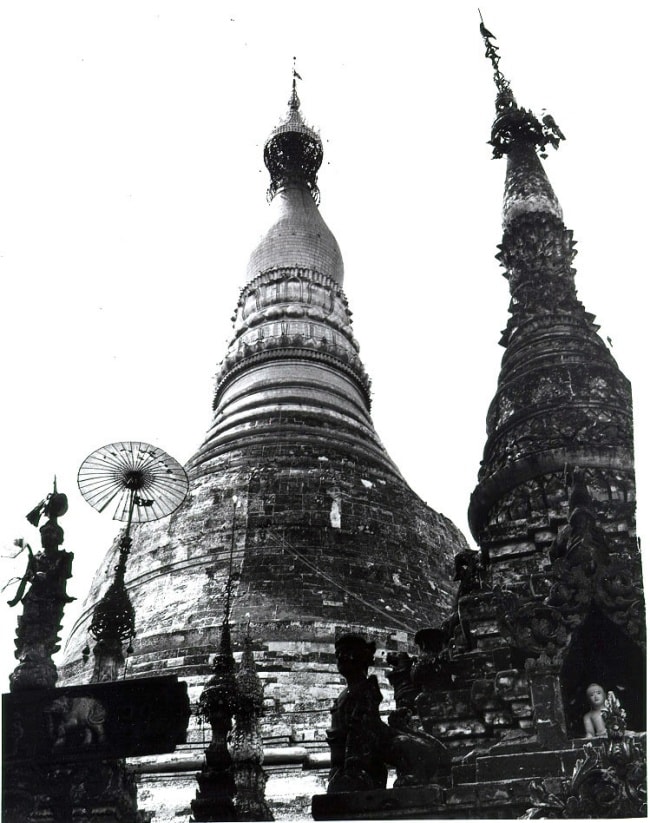
The development of the pagoda
Subsequently, the stupa fell into disrepair until the 14th century, when King Binnya U (1323–1384) rebuilt it to a height of 18 meters. A century later, Queen BinnyaThau (1453–1472) raised its height to 40 meters. She terraced the hill on which it stands, paved the top terrace with flagstones, and assigned land and dedicated hereditary workers for its maintenance.
Her son-in-law undertook a series of significant repairs and renovations to the Shwedagon. An in-situ inscription catalogues a list of repairs beginning in 1436 and finishing during Dhammazedi's reign. By the beginning of the 16th century, the Shwedagon Pagoda had become the most famous Buddhist pilgrimage site in Burma, and one of the most frequented pilgrimage destinations among the wider Buddhist community of South and Southeast Asia.
A series of earthquakes during the following centuries caused some damage to the pagoda, the worst of which was a 1768 earthquake that brought down the top of the stupa, but King Hsinbyushin (1763-1776) later raised it to its current height of 99 meters. A new crown umbrella was donated by King Mindon Min in 1871 after the annexation of Lower Burma by the British, increasing the height of the monument to its current 112 meters.
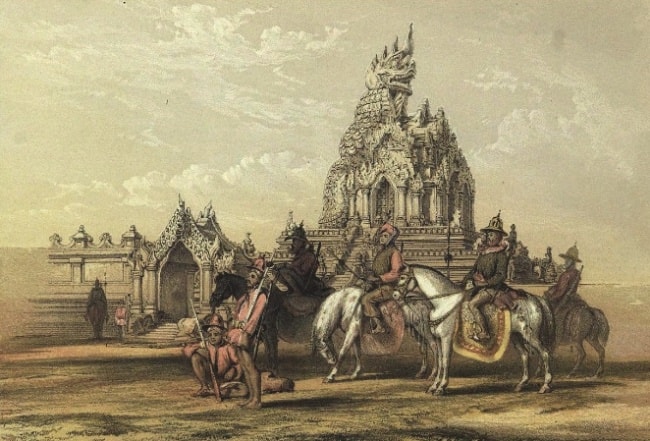
Over time, many shrines have been added to the site. The stupa atop Singuttara Hill is now surrounded by hundreds of monasteries on three terraced platforms (pissaya), imparting to the site the form of a three-dimensional mandala (representation of the cosmos). The property contains the hill, its encircling levels and monasteries, covered staircases, a uppermost platform with pavilions, bells, planetary posts and astrological directionality, upon which the central stupa accessed through four devotional halls (ayongantazaung), oriented to the cardinal directions.
With a traditional history dating to the time of the historical Gautama Buddha (ca 6th century BCE) and a recorded history since the 14th century CE, the Shwedagon on Singuttara Hill has sustained and evolved a unique expression of the timeless Buddhist teachings inspired and energized by the cosmological significant of the hill as a sacred place.
The numerous structures on the hill, notably the reliquary stupa, but also includingthe directional devotional halls (ayongantazaung), monasteries, pavilions and donation halls on the ascending terraced platforms (pissaya) have stimulated and sustained the distinctive and outstanding repertoire of artistic expressions, the intent of which is to propagate, through tangible, didactic expressions of devotion, the sublime, ageless teaching of the Buddha(s).
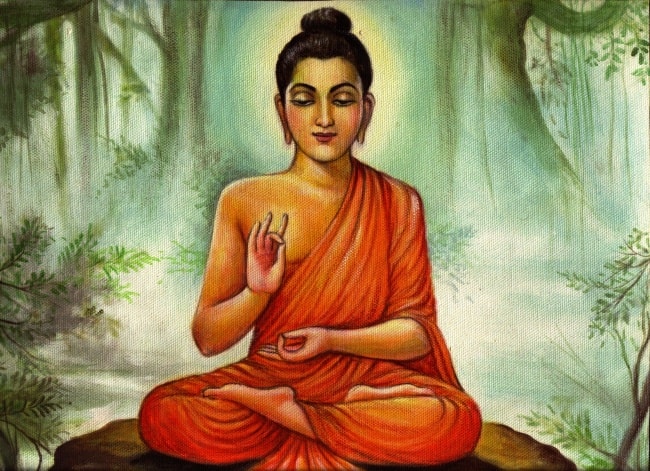
The design of Shwedagon Pagoda
The stupa's plinth is made of bricks covered with gold plates. Above the base are terraces that only monks and other males can access. Next is the bell-shaped part of the stupa. Above that is the turban, then the inverted almsbowl, inverted and upright lotus petals, the banana bud and then the umbrella crown. The crown is tipped with 5,448 diamonds and 2,317 rubies. Immediately before the diamond bud is a flag-shaped vane. The very top—the diamond bud—is tipped with a 76 carat (15 g) diamond.
The gold seen on the stupa is made of genuine gold plates, covering the brick structure and attached by traditional rivets. People all over the country, as well as monarchs in its history, have donated gold to the pagoda to maintain it. The practice continues to this day after being started in the 15th century by the Queen Shin Sawbu (Binnya Thau), who gave her weight in gold.
There are four entrances, each leading up a flight of steps to the platform on Singuttara Hill. A pair of giant leogryphs guards each entrance. The eastern and southern approaches have vendors selling books, good luck charms, images of the Buddha, candles, gold leaf, incense sticks, prayer flags, streamers, miniature umbrellas and flowers.
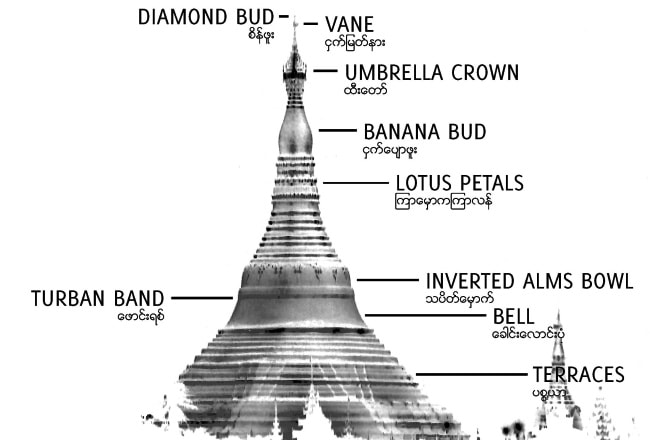
It is customary to circumnavigate Buddhist stupas in a clockwise direction. In accordance with this principle, one may begin at the eastern directional shrine, which houses a statue of Kakusandha, the first Buddha of the present kalpa. Next, at the southern directional shrine, is a statue of the second Buddha, Koṇāgamana. Next, at the western directional shrine, is that of the third Buddha, Kassapa. Finally, at the northern directional shrine, is that of the fourth Buddha, Gautama.
The form of the Shwedagon has become the prototype for stupa design within Myanmar and abroad. It is the direct descendant of the Shwezigon stupa of 12th century CE Bagan, keeping the basic form of the bell and lotus leaves while modifying the form of the upper octagonal and circular terraces and the ornamental umbrellas on top (hti) and replacing the staircases with satellite stupas on the first square terrace.
The spatial experience of the Shwedagon space is intensified by the ascent up the shaded covered stairways onto the wide top-most platform on which the main stupa is located, open to the sky. The movement of pilgrims and visitors on the circumambulatory walkways around the central stupa and in front of and inside numerous shrines defines a meaningful and fluid architectural space that separates the stupa from its surrounding spatial envelope.
The outer rim contains over a hundred religious structures, numerous bells and other devotional objects, and many sacred trees. On the northwest edge of the platform is a chute to discard and re-cycle offerings (of flowers, candles, and incense) into new images sold in aid of the pagoda’s sustenance. The development of many architectural norms such as the tiered roof (pyat-that), wooden sculptural reliefs, glass-mosaic work and the art of bell-casting have been stimulated and enabled by the continuous patronage of the Shwedagon.
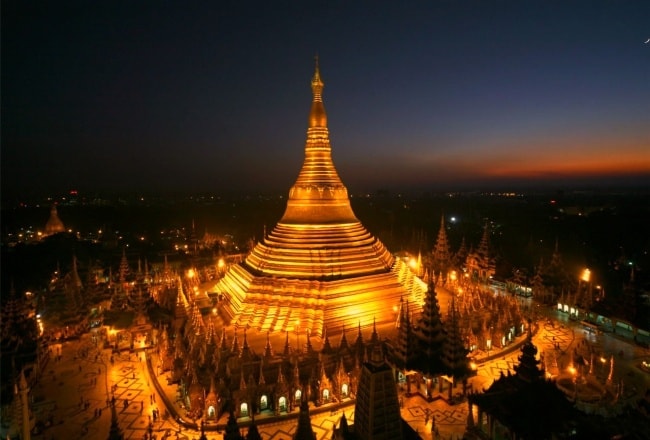
Shwedagon Pagoda’s Rituals
Most Burmese people are Theravada Buddhists, and many also follow practices which originated in Hindu astrology. Burmese astrology recognizes the seven planets of astrology — the Sun, Moon, Mercury, Venus, Mars, Jupiter, and Saturn. In addition, it recognizes two other planets, Rahu and Ketu. All the Burmese names of the planets are borrowed from Hindu astrology, but the Burmese Rahu and Ketu are different from the Hindu Rahu and Ketu.
The Burmese consider them to be distinct and separate planets, whereas Hindu astrology considers them to be either the Dragon's Head and Tails or Ascending and Descending Nodes. To the Burmese people, Ketu is the king of all planets. As in many other languages, the Burmese name the seven days of their week after the seven planets, but Burmese astrology recognizes an eight-day week, with Wednesday being divided into two days; until 6 p.m. it is Wednesday, but after 6.pm. until midnight it is Rahu's day.
It is important for Burmese Buddhists to know on which day of the week they were born, as this determines their planetary post. There are eight planetary posts, as Wednesday is split in two (a.m. and p.m.). They are marked by animals that represent the day — garuda for Sunday, tiger for Monday, lion for Tuesday, tusked elephant for Wednesday morning, tuskless elephant for Wednesday afternoon, mouse for Thursday, guinea pig for Friday and nāga for Saturday.
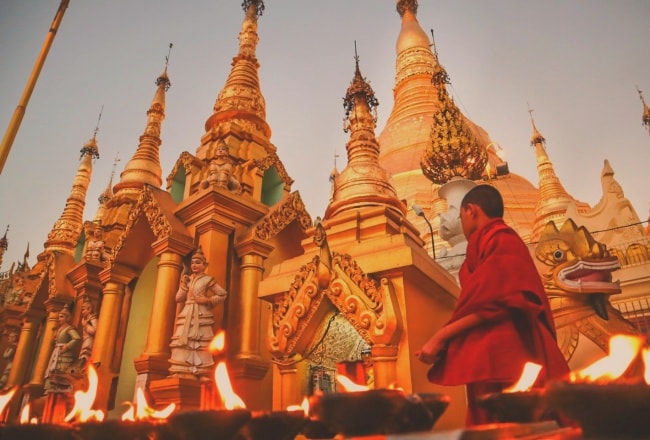
Each planetary post has a Buddha image and devotees offer flowers and prayer flags and pour water on the image with a prayer and a wish. At the base of the post behind the image is a guardian angel, and underneath the image is the animal representing that particular day. The plinth of the stupa is octagonal and also surrounded by eight small shrines (one for each planetary post). It is customary to circumnavigate Buddhist stupas in a clockwise direction.
The pilgrim, on his way up the steps of the pagoda, buys flowers, candles, coloured flags and streamers. These are to be placed at the stupa in a symbolic act of giving, which is an important aspect of Buddhist teaching. There are donation boxes located in various places around the pagoda to receive voluntary offerings which may be given to the pagoda for general purposes.
The activities at the Shwedagon Pagoda express tangibly the living tradition of the veneration of relics, a specific cult tradition that has early origins in the history of Buddhist devotional practice, and since the 14th century has held a central and widespread role in Buddhist worship throughout all regions of South, Central, East, and Southeast Asia. In terms of global correspondence, comparison may be made with contemporary Christian and Islamic devotional practices related to veneration of relics of saints.
At the Shwedagon, the individual and communal Buddhist practices of the devotees are incontrovertibly associated with the monumental expression of the stupa situated atop the Singuttara Hill. Pilgrims choose their route, typically circumambulation, veneration of the images of the four Buddhas of this era (kalpa), wish-offering at planetary shrines and obeisance to cult images.
The ensemble illustrates the seamless mixture of the propagation of canonical teachings, the practice of meditation, devotion to popular cults, and belief in numerology and astrology.The multiple, fluid pathways of each pilgrim over centuries have created and sustained an intangible heritage unique to the Shwedagon Pagoda on Singuttara Hill.
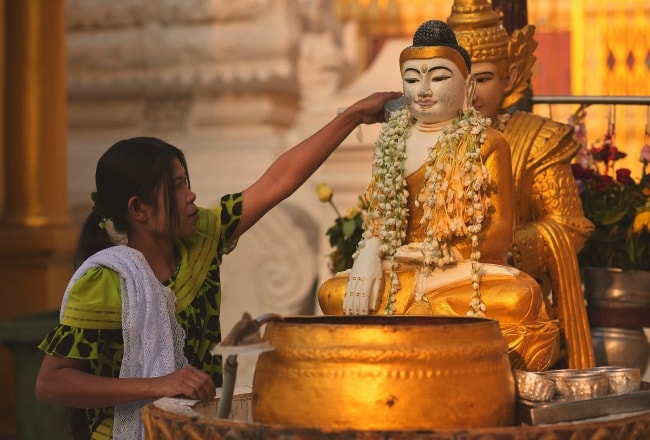
Shwedagon Pagoda Festival
The Shwedagon Pagoda Festival is one of Myanmar’s largest religious gatherings.
The multiple day celebration takes place in Yangon’s iconic Shwedagon Pagoda centering on the legendary golden stupa shrine said to contain hairs from Gautama Buddha. The festival permeates the sprawling shrine and temple complex with a reverent atmosphere reinforced by the devotions of the thousands of pilgrims. Throughout the festival, red robed Buddhist monks lead the attendees in Buddhist rituals.
Pilgrims circle the central golden stupa of Shwedagon Pagoda in a clockwise rotation in an ancient tradition believed to garner religious merit. During the festival, the pagoda is ringed by the flames and smoke of thousands of candles and incense sticks lit by the pilgrims as offerings of good fortune. The monks who preside over the Shwedagon Pagoda will receive large donations from pilgrims and Yangon’s residents during the festival to support themselves and the temple through the next year.
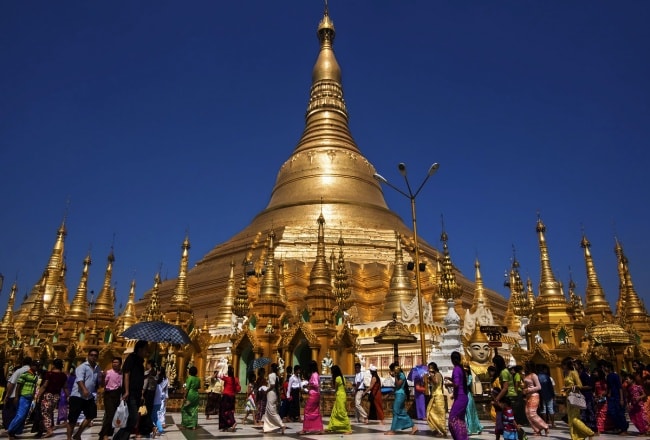
When is Shwedagon Pagoda Festival?
The Shwedagon Pagoda Festival usually falls between February and March. Festival dates in Myanmar are determined with a traditional Buddhist calendar based on the phases of the moon, which can cause holidays to fall on a wide range of days. If you’re interested in visiting the Shwedagon Pagoda Festival, you can find the date below for your reference. Do not hesitate to contact our travel expert to arrange the your services during this busy period.
| Year | Start Date | End Date |
|---|---|---|
| 2025 | 18 March | 27 March |
| 2026 | 21 February | 2 March |
| 2027 | 25 February | 6 March |
| 2028 | 16 March | 25 March |
Shwedagon in literature
Rudyard Kipling described his 1889 visit to Shwedagon Pagoda ten years later in From Sea to Sea and Other Sketches, Letters of Travel
Then, a golden mystery upheaved itself on the horizon, a beautiful winking wonder that blazed in the sun, of a shape that was neither Muslim dome nor Hindu temple-spire. It stood upon a green knoll, and below it were lines of warehouses, sheds, and mills. Under what new god, thought I, are we irrepressible English sitting now?
'There's the old Shway Dagon' (pronounced Dagone), said my companion. 'Confound it!' But it was not a thing to be sworn at. It explained in the first place why we took Rangoon, and in the second why we pushed on to see what more of rich or rare the land held. Up till that sight my uninstructed eyes could not see that the land differed much in appearance from the Sunderbuns, but the golden dome said: 'This is Burma, and it will be quite unlike any land you know about.' 'It's a famous old shrine o' sorts,' said my companion, 'and now the Tounghoo-Mandalay line is open, pilgrims are flocking down by the thousand to see it. It lost its big gold top - 'thing that they call a 'htee - in an earthquake: that's why it's all hidden by bamboo-work for a third of its height. You should see it when it's all uncovered. They're regilding it now.'

War and invasion
In 1608 the Portuguese adventurer Filipe de Brito e Nicote, known as Nga Zinka to the Burmese, plundered the Shwedagon Pagoda. His men took the 300-ton Great Bell of Dhammazedi, donated in 1485 by King Dhammazedi. De Brito's intention was to melt the bell down to make cannons, but it fell into the Bago River when he was carrying it across. To this date, it has not been recovered.
Two centuries later, the British landed on May 11, 1824 during the First Anglo-Burmese War. They immediately seized and occupied the Shwedagon Pagoda and used it as a fortress until they left two years later. There was pillaging and vandalism, and one officer's excuse for digging a tunnel into the depths of the stupa was to find out if it could be used as a gunpowder magazine.
The Maha Gandha (lit. great sweet sound) Bell, a 23-ton bronze bell cast in 1779 and donated by King Singu and popularly known as the Singu Min Bell, was carried off with the intention to ship it to Kolkata. It met the same fate as the Dhammazedi Bell and fell into the river.
When the British failed in their attempts to recover it, the people offered to help provided it could be restored to the stupa. The British, thinking it would be in vain, agreed, upon which divers went in to tie hundreds of bamboo poles underneath the bell and floated it to the surface.
There has been much confusion over this bell and the 42-ton Tharrawaddy Min Bell donated in 1841 by Tharrawaddy Min along with 20 kg of gold plating; this massive ornate bell hangs in its pavilion in the northeast corner of the stupa.
A different but less plausible version of the account of the Singu Min Bell was given by Lt. J.E. Alexander in 1827. This bell can be seen hung in another pavilion in the northwest of the pagoda platform.
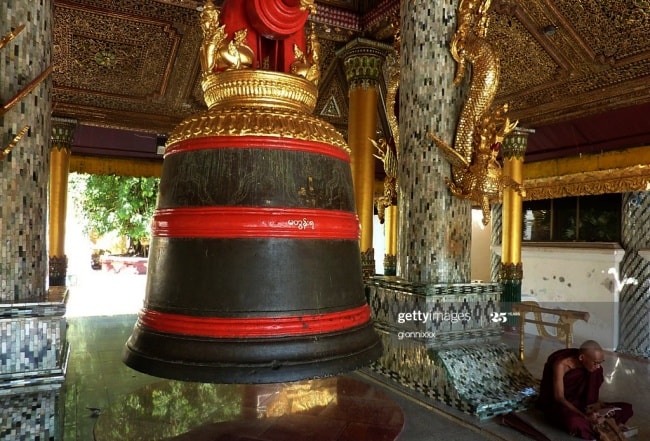
The Second Anglo-Burmese War saw the British re-occupation of the Shwedagon in April 1852, only this time the stupa was to remain under their military control for 77 years, until 1929, although the people were given access to the Paya.
During the British occupation and fortification of the Pagoda, Lord Maung Htaw Lay, the most prominent Mon-Burmese in British Burma, successfully prevented the British Army from looting of the treasures; he eventually restored the Pagoda to its former glory and status with the financial help from the British rulers. This extract is from the book “A Twentieth Century Burmese Matriarch” written by his great-great-great granddaughter Khin Thida.
After retirement he moved back to Rangoon area still in Burmese hands but very soon destined for the next annexation. He was again caught up in war but this time he had a great fortune of supporting religious ventures and gaining tremendous merit. His good karma and leadership abilities led him to the task of saving the great Shwedagon Pagoda from imminent destruction and sacking of its treasures by British troops in the second Anglo-Burmese War.
The great Buddhist shrine had been fortified by the British troops in the 1824 war and was again used as a fort in 1852. When he heard of the fortification and sacking of the shrine, he sent a letter of appeal directly to the British India Office in London stopping the desecration. He then obtained compensation from the British Commissioner of Burma Mr. Phayre and began the renovations of the Pagoda in 1855 with public support and donations.
He became the founding trustee of the Shwedagon Pagoda Trust and he was awarded the title of KSM by the British Raj for his public service. He died at the age of 95, bequeathing his prestige and high repute to his large family and descendants.
Below is the short brief of the history of Shwedagon Pagoda until the modern time.
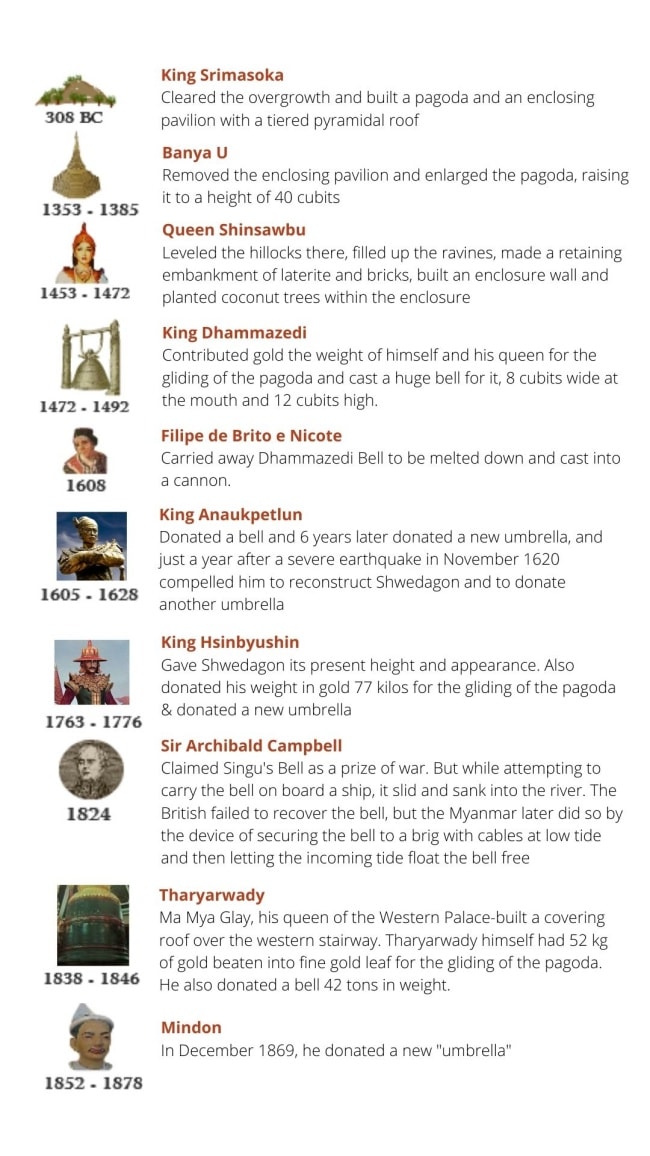
Political area
In 1920, students from Burma's only university met at a pavilion on the southwest corner of the Shwedagon pagoda and planned a protest strike against the new University Act which they believed would only benefit the elite and perpetuate colonial rule. This place is now commemorated by a memorial. The result of the ensuing University Boycott was the establishment of "national schools" financed and run by the Burmese people; this day has been commemorated as the Burmese National Day since. During the second university students strike in history of 1936, the terraces of the Shwedagon were again where the student strikers camped out.
In 1938, oilfield workers on strike hiked all the way from the oilfields of Chauk and Yenangyaung in central Burma to Rangoon to establish a strike camp at the Shwedagon Pagoda. This strike, supported by the public as well as students and came to be known as the '1300 Revolution' after the Burmese calendar year, was broken up by the police who, in their boots whereas Burmese would remove their shoes in pagoda precincts, raided the strike camps on the pagoda.
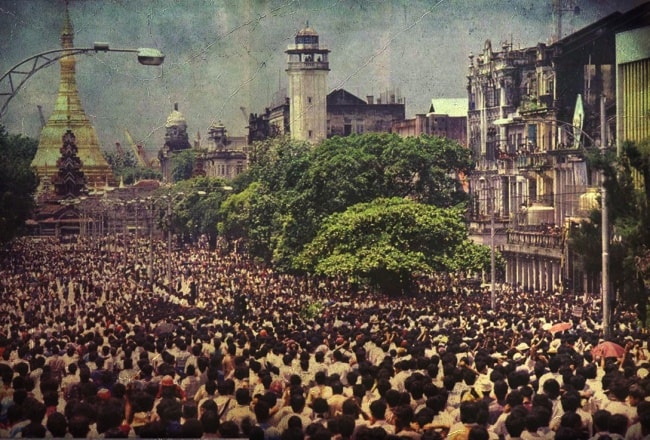
The "shoe question" on the pagoda has always been a sensitive issue to the Burmese people since colonial times. The Burmese people had always removed shoes at all Buddhist pagodas. Hiram Cox, the British envoy to the Burmese Court, in 1796, observed the tradition by not visiting the pagoda rather than take off his shoes. However, after the annexation of lower Burma, European visitors as well as troops posted at the pagoda openly flouted the tradition.
U Dhammaloka publicly confronted a police officer over wearing shoes at the pagoda in 1902. It was not until 1919 that the British authorities finally issued a regulation prohibiting footwear in the precincts of the pagoda. However, they put in an exception that employees of the government on official business were allowed footwear. The regulation and its exception clause moved to stir up the people and played a role in the beginnings of the nationalist movement. Today, no footwear or socks are allowed on the pagoda.
In January 1946, General Aung San addressed a mass meeting at the stupa, demanding "independence now" from the British with a thinly veiled threat of a general strike and uprising. Forty-two years later, on August 26, 1988, his daughter, Aung San Suu Kyi addressed another mass meeting of 500,000 people at the stupa, demanding democracy from the military regime and calling the 8888 Uprising the second struggle for independence.
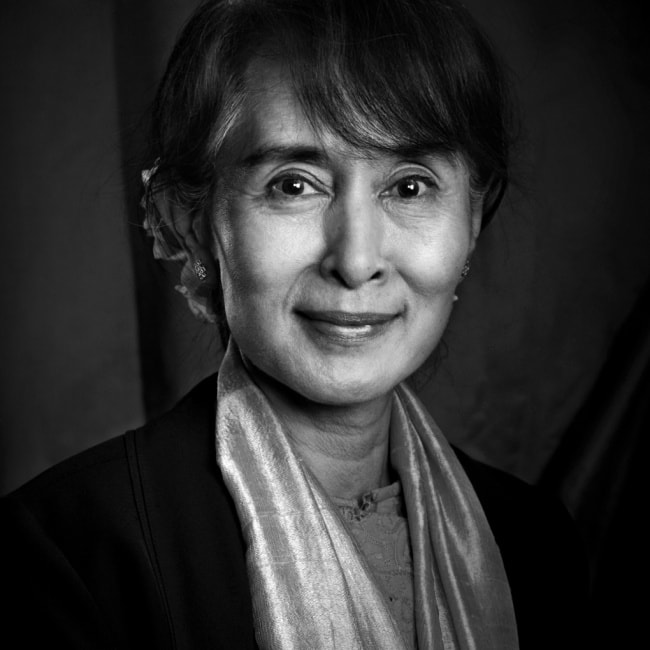
September 2007 protests
In September 2007, during nationwide demonstrations against the military regime and its recently enacted price increases, protesting monks were denied access to the pagoda for several days before the government finally relented and permitted them in.
On September 24, 2007, 20,000 bhikkhus and thilashins (the largest protest in 20 years) marched at the Shwedagon Pagoda, Yangon. On Monday, 30,000 people led by 15,000 monks marched from Shwedagon Pagoda and past the offices of Aung San Suu Kyi's opposition National League for Democracy (NLD) party.
Comedian Zarganar and star Kyaw Thu brought food and water to the monks. On Saturday, monks marched to greet Aung San Suu Kyi, who is under house arrest. On Sunday, about 150 nuns joined the marchers. On September 25, 2007, 2,000 monks and supporters defied threats from Myanmar's junta.
They marched to Yangon streets at Shwedagon Pagoda amid army trucks and the warning of Brigadier-General Myint Maung not to violate Buddhist "rules and regulations."
On September 26, 2007, clashes between security forces and thousands of protesters led by Buddhist monks in Myanmar have left at least five protesters dead by Myanmar security forces, according to opposition reports, in an anticipated crackdown.
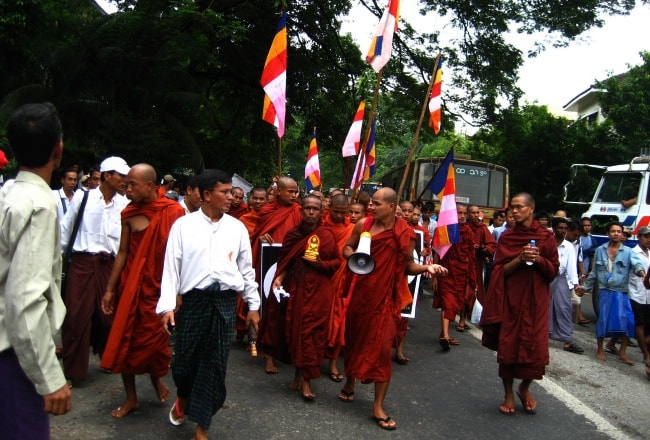
Earlier in the day security authorities used tear gas, warning shots and force to break up a peaceful demonstration by scores of monks gathered around the Shwedagon Pagoda.
The web site reports that protesting "monks were beaten and bundled into waiting army trucks," adding about 50 monks were arrested and taken to undisclosed locations.
In addition, the opposition said "soldiers with assault rifles have sealed off sacred Buddhist monasteries ... as well as other flashpoints of anti-government protests."
It reports that the violent crackdown came as about 100 monks defied a ban by venturing into a cordoned-off area around the Shwedagon Pagoda, Myanmar's holiest Buddhist shrine.
It says that authorities ordered the crowd to disperse, but witnesses said the monks sat down and began praying, defying the military government's ban on public assembly. Security forces at the pagoda "struck out at demonstrators" and attacked "several hundred other monks and supporters," the opposition web site detailed.
Monks were ushered away by authorities and loaded into waiting trucks while several hundred onlookers watched, witnesses said. Some managed to escape and headed towards the Sule Pagoda, a Buddhist monument and landmark located in Yangon's city centre.
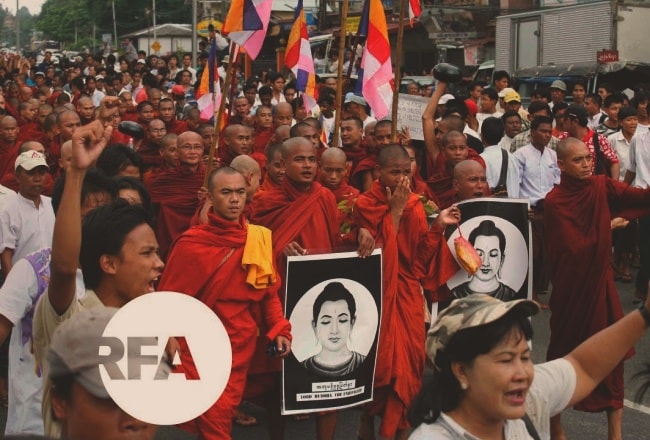
Replicas of Shwedagon Pagoda
Uppatasanti Pagoda - located in Naypyidaw, the capital of Myanmar - is a replica of Shwedagon Pagoda. Completed in 2009, it is similar in many aspects to Shwedagon Pagoda, but its height is 30 cm (12 in) less than that of Shwedagon.
Another replica of Shwedagon Pagoda, 46.8 m (154 ft) in height, was constructed at Lumbini Natural Park in Berastagi, North Sumatra, Indonesia. Completed in 2010, the construction materials for this pagoda, were imported from Myanmar.
Global Vipassana Pagoda, 29 m (95 ft) high and opened in 2009, located in Mumbai, India
A guide for visiting Shwedagon Pagoda
Undeniably the country’s most stunning Buddhist structure, Myanmar’s Shwedagon Pagoda enchants all those who tread upon its dazzling 114-acre complex in the heart of Yangon. The Shwedagon is more than a national icon - it’s a treasure - and basking in its magnificence is an absolute must. Here’s how to get the most out of experiencing this ancient wonder of the world.
Reflective of Myanmar’s resilience, the Shwedagon Pagoda shines on
Situated at the top of Singuttara Hill and overlooking the city, this incredibly sacred place has witnessed Myanmar’s dynamic, ever-changing history over the course of an estimated 2,500 years. The Shwedagon has endured severe natural disasters, military occupation, been the site of historic public speeches and protests; and yet, its grandeur exists today to tell each century’s story in the faintest sounds of bells and the loudest patters of bare feet.
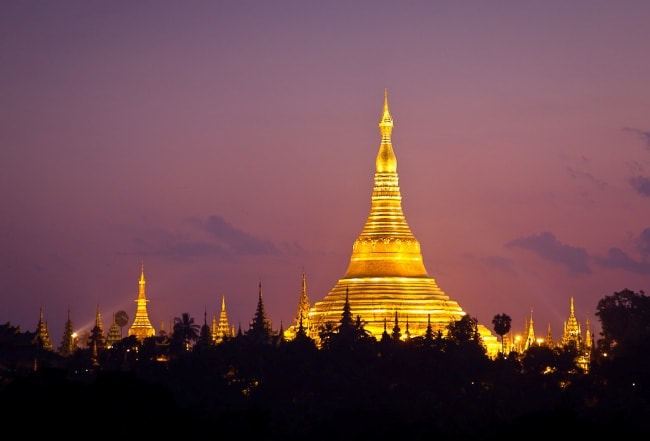
A welcome fit for royalty upon entrance to the Shwedagon
Say mingalabar to the massive pairs of chinthe guarding each of the four covered walkways, known as zaungdan, leading up to the Shwedagon Paya. It’s common to find these colossal lion-like creatures securing the perimeter of temples in Myanmar.
The Shwedagon’s southern entrance is considered the main way to get in, and all but the western entryways are bustling with merchants selling anything from flowers and incense to antiques and souvenirs.
Perhaps the grandest of the entrances with its marble floors and regal columns, the western gate creates the feeling of entering a dreamy palace. This entry also has escalators. If an elevator is necessary, use the southern, northern or eastern gates.
The Shwedagon Pagoda is open daily from 4 a.m.–10 p.m. There’s an approximately US$8 cash-only entrance fee for foreigners. ATMs and moneychangers are located at various points within the grounds of the Shwedagon. Dress modestly and remove shoes. For a small donation, footwear can be dropped off on the way up to the main platform.
It’s possible to book a guided tour to learn even more about the Shwedagon while visiting, or locals hoping to make some extra cash and practice English will eventually surface from the crowd and gladly serve as guides.
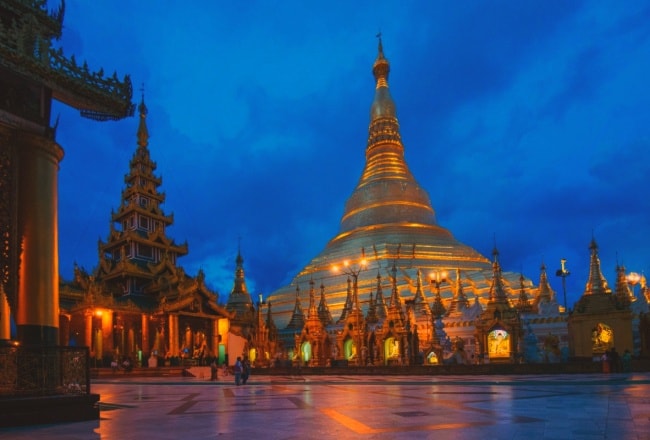
The Shwedagon Pagoda in Yangon is a glimpse of glitz and glam
For the most idyllic first impression of Myanmar’s Shwedagon Pagoda in all its glory, enter from the northern covered walkway. The central stupa, rising approximately 325 feet above the terrace, is perfectly framed from this angle.
Surrounding the towering bell-shaped stupa, referred to as a zedi in Burmese, are 64 smaller stupas and four larger cardinal corner ones. 12 planetary posts representing days of the week and the moon’s ascension also encompass the zedi’s base.
It’s hard to fathom or even accurately measure the amount of gold—by the ton—the Shwedagon actually has. The main zedi is plated with tens of thousands of solid gold bars, and the spired umbrella (hti) top, intricately adorned with thousands of diamonds, precious stones and golden bells, is estimated to be worth an astonishing US$3 billion on its own.
What to see and do at the Shwedagon besides becoming enthralled by its wealth
After marveling at the richness of the Shwedagon, it’s time to explore. Head to one of the numerous prayer pavilions for a prime people-watching perch. From here local couples can be seen holding hands, Myanmar families can be spotted praying together, and many tourists as well as monks and nuns from all over the world can be identified.
Perhaps find a quieter worship hall to mediate or let a temple cat lead you astray. But, beware. The colorful, swirling lights around many of the Shwedagon’s images of Buddha have a way of mesmerizing visitors for hours.
Before leaving, pour water over the Buddha statue at the station or “corner” that represents the day of your birth, and ding a few deep tonal dongs out of the Tharrawaddy Min Bell – one of two unbelievably big cast-iron bells displayed at the Shwedagon.
The Naungdawgyi Paya near the north entrance is worth mentioning. It’s believed to be the original site where eight Buddha hair relics were enshrined. There’s also a small museum near the northwestern corner of the pagoda level, open from 9 a.m.–4 p.m., Tuesday to Sunday, and a nearby photo gallery offering close-ups of the ornate hti atop the main zedi.
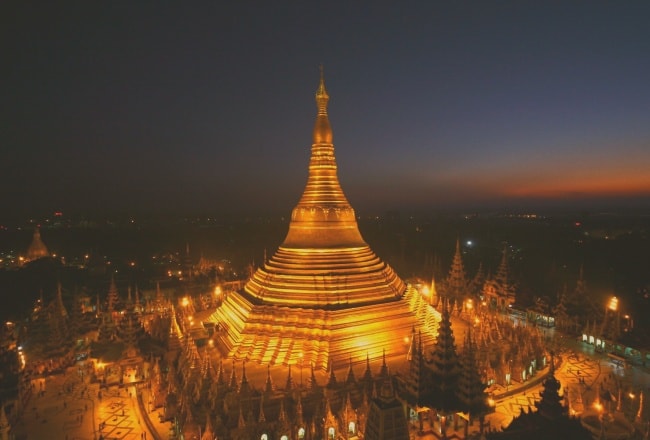
At dawn, dusk and during Buddhist holidays is when to visit the Shwedagon
To see the Shwedagon Pagoda gilded in glorious golden light, the best and busiest times to go are around sunrise and sunset. Venturing to the Shwedagon during the afternoon might not be as crowded, but it’ll be scorching hot depending on the season.
Go during Buddhist holidays such as Thingyan, Thadingyut and Tazaungdaing for an especially memorable experience.
The Shwedagon Pagoda’s path less traveled
Take the lower footpath encircling the compound for a quieter stroll to see the Shwedagon from a different perspective. This pathway is accessible from all four entrances and isn’t as frequented by tourists. It’s the perfect way to take time to fully process the awesomeness of experiencing Myanmar’s Shwedagon Pagoda.
The facts of Shwedagon Pagoda
99-Meter-tall gold-plated stupa topped with diamond studded hti
The elegant Shwedagon Pagoda is Yangon’s most famous landmark. The massive 99-meter-high gold-plated pagoda with the diamond studded spire set on top of a small hill in downtown Yangon dominates the area and is visible from much of the city. After dark there is a mystical atmosphere with the pagoda lit up by spotlights.
The very impressive pagoda, also known as the Golden Pagoda, is Burma’s most important Buddhist pilgrimage site. The main stupa enshrines sacred relics of the Gautama Buddha as well as the three previous Buddhas.
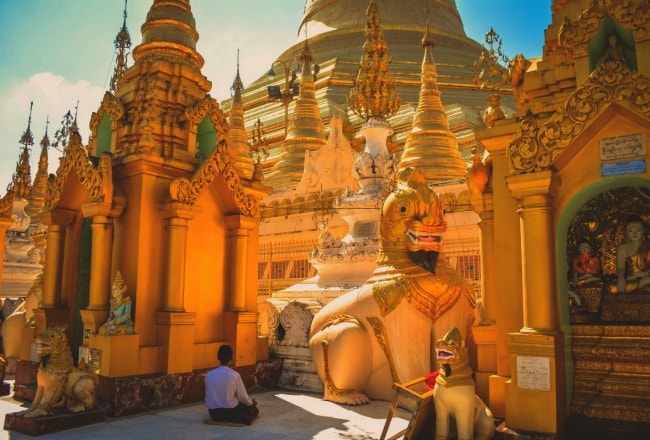
The Sularata Nat that found the spot to build the pagoda
According to legend two merchant brothers from Okkalapa (present day Yangon) who lived about 2,500 years ago met the Buddha in India. The Buddha gave them eight of His hairs and told them to enshrine them in the same spot on a hill in Okkalapa where relics of the previous three reincarnations of the Buddha were buried.
The brothers returned to Okkalapa and presented the Buddha relics to their King, who started searching for the spot. After years of searching in vain a Nat spirit called Sularata decided to help the King. The Nat who was millions of years old hat witnessed the visits of the previous three Buddhas and remembered the spot on Singuttara hill where the relics were enshrined. It was at this spot that the Shwedagon pagoda was built.
Four entrances guarded by Chinthes
There are four entrances to the complex, all of which except the Eastern one have either an escalator or an elevator. All are guarded by enormous Chinthes, Burmese mythological lions with a white body and golden colored head.
The upper part of the walls at the entrances to the complex are decorated with beautiful Burmese style depictions of the Jataka tales, the stories about the previous lives of the Buddha.
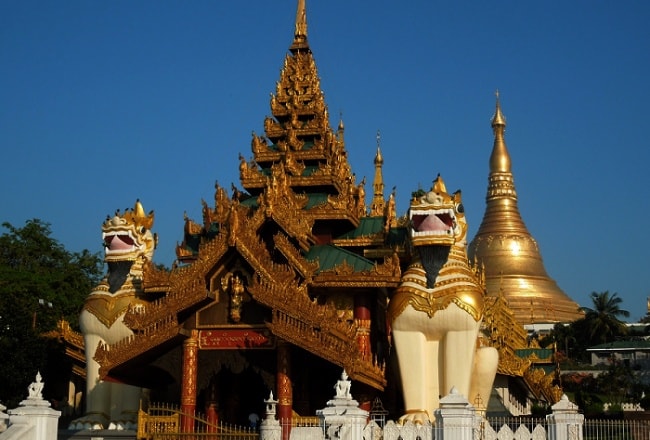
Center of the complex
The center of the large complex is formed by a large platform measuring 275 meters long with the main stupa and many smaller stupas surrounding it. The main stupa enshrines relics of the four previous Buddhas including sacred hair relics of the most recent Buddha.
Since the Shwedagon Pagoda is the most sacred place for Buddhists in Burma, large numbers of devotees come to the Shwedagon every day. They walk around the stupa and make offerings to the Buddha.
At each corner of the octagonal pagoda is a shrine with a Buddha image (one for each day of the week, Wednesday is split into two). Every shrine has a planet and an animal sign associated with it in accordance with Eastern astrology. Burmese people pray to the shrine belonging to their day of birth burning candles, offering flowers and pouring water over the image.
The gold-plated main stupa with the diamond studded hti
The main stupa is the temple’s most impressive structure. It is visible at its hilltop location from much of Yangon city. The stupa is surrounded by 64 small stupas.
The 99 meters high main stupa is completely covered with gold plating and enshrines the sacred Buddha relics. Its core is solid and not open to the public.
A seven spired hti, an ornament shaped as an umbrella with golden bells attached to it is placed at the top of the pagoda. The hti is decorated with thousands of diamonds and other precious stones.
If you stand in the right spot of the pagoda platform, you will see the reflection of the rays of the sun from the huge diamond on top of the gold plated hti in various colors like red, purple and orange.
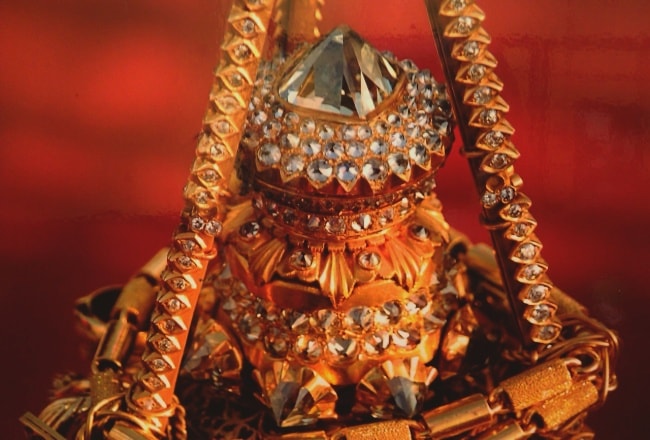
The hair relic of the Buddha
According to legend two Burmese brothers met the Buddha not long after he had reached enlightenment. The Buddha gave the brothers eight of his hairs and told them to enshrine the hair relics on Singuttara Hill, where relics of the three previous Buddhas had already been enshrined. The brothers returned to Burma and gave the Buddha’s hair relics to the King. The spot where the relics of previous Buddhas were enshrined was found. At that spot a relic chamber was built and a Pagoda was built over it.
The world’s largest bell
Dhammazedi, King of the Pegu Kingdom during the end of the 15th century had an enormous bell cast in the year 1484. The bell, that is believed the largest bell ever cast weighing almost 300 tons was installed in the Shwedagon Pagoda.
In 1608 a Portuguese named Philip de Brito e Nicote who ruled Syriam (present day Thanlyin) as a Portuguese colony stole the Great Bell as he wanted to melt it down to produce cannons. The raft carrying the bell however sunk in the Yangon river. The bell is still at the bottom of the river today.
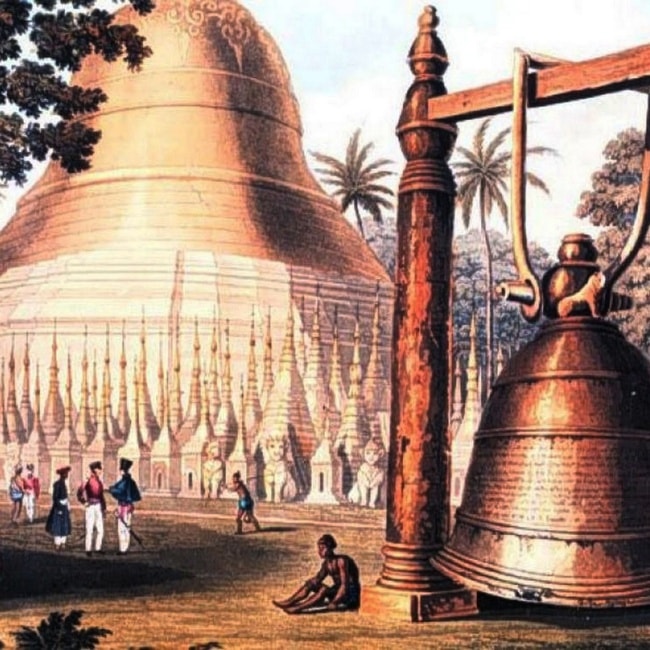
Visiting Information
Best Times to Visit
Aside from Buddhist holidays based on the lunisolar calendar, weekdays are often more quiet at the Shwedagon Pagoda. The site is busier during Buddhist Lent (usually in June). Many Buddhist holidays start the day before a full moon.
You’ll get much better light for stunning travel photographs if you visit early in the morning. Temperatures can climb to almost 100 degrees by noon, making the white marble flooring hot on bare feet!
Visiting the Shwedagon Pagoda after dark is an entirely different experience. An ideal scenario would be to visit in the morning when light is good for photos and before the heat of the day, go explore some other interesting sights in Yangon, then return to the pagoda in the evening when everything is lit up.
The dry season in Yangon is from November to April. The months of June, July, and August are usually the rainiest.
How to get to the Shwedagon Pagoda
The Shwedagon Pagoda is located on Sanguttara Hill in the Dagon Township of Yangon in Burma/Myanmar. Any taxi driver in Yangon will gladly take you. There’s no need to have the driver wait; plenty of taxis will be waiting around the pagoda when you exit.
Although taxis are very reasonably priced in Yangon, prices are slightly inflated for tourists who are visiting the pagoda. Don’t be afraid to negotiate a little with your driver.
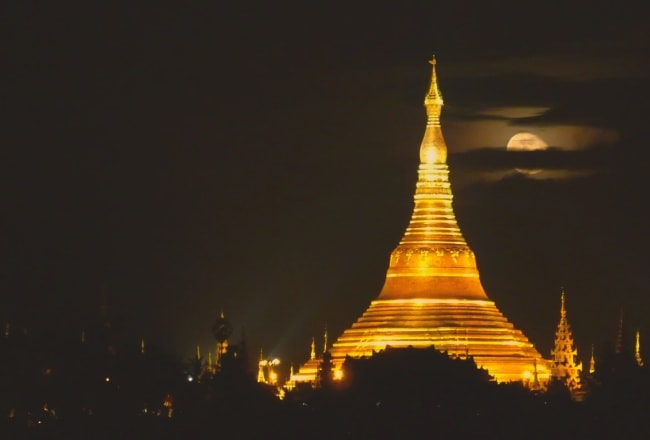
Opening hours
The Shwedagon Pagoda is open every day of the year from 04:00 AM to 22:00 PM. Last admission is at 21:45.
On two days of the year, the Waxing Day of Tabaung – the day before full moon day of the Myanmar Lunar month Tabaung in March and on the Waxing Day of Wakhaung – the day before full moon day of the Myanmar Lunar month Wakhaung the pagoda is open 24 hours a day.
Visitor Center: The visitor center is open daily from 8 a.m. to 9 p.m.
Accessibility: Elevators and wheelchairs are available at the southern entrance of the pagoda.
Water: Communal water coolers are available around the pagoda, but you may want to bring your own water. Bring a hat and sunscreen; afternoon temperatures in Yangon are hot throughout the year.
Food: Although food carts are available around the monument, you'll find better food in local restaurants elsewhere.
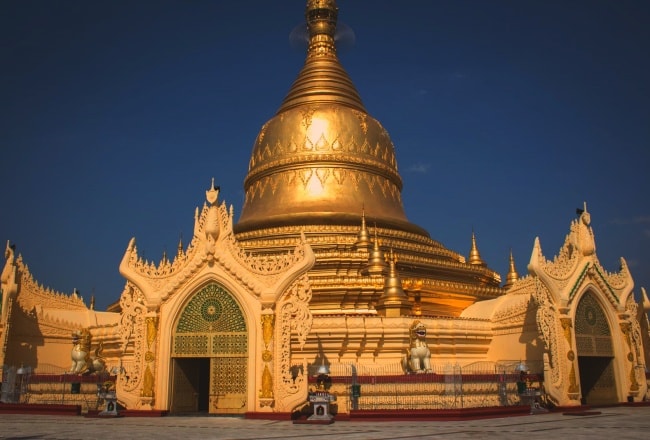
Dress Code
Although you should dress conservatively (cover your knees and shoulders) when visiting any of the temples in Southeast Asia, the rules are often more relaxed for tourists in places such as Thailand. That’s not the case at the Shwedagon Pagoda. The pagoda is much more than a tourist attraction, it is the most important religious site in Myanmar. It also functions as a very active place of worship. Scores of monks, pilgrims, and devotees mix among tourists at the monument.
Men and women should wear clothing that covers the knees. Longyi, a traditional, sarong-style garment, are available to borrow at the entrances. Shoulders should not be exposed. Avoid shirts with religious themes or offensive messages (that includes skulls). Tight or revealing clothing should be avoided. Although the official website for the pagoda claims that elbow-length shirts are required, this is rarely enforced.
You’ll be expected to remove your shoes and leave them at the entrance for a small fee. Shoes are looked after at a proper counter, hence the fee. You'll be given a numbered claim check so don’t worry about someone swapping flip-flops with you. Socks and stockings are not allowed, you must go in bare feet.
Entrance fee
- Entrance fee to Shwedagon is $8 per person.
- A guide will cost an additional $5.
- Donation boxes are also available throughout the pagoda.
Hotels near Shwedagon Pagoda
Here are some recommended hotel near Shwedagon Pagoda for your reference
- Merchant Art Hotel: Situated in Yangon, 1.3 km from Shwedagon Pagoda, Merchant Art Hotel features accommodation with a restaurant, free private parking, a bar and a garden.
- Bodhi Nava Boutique Hostels & Cafe: Situated a 6-minute walk from Shwedagon Pagoda, Bodhi Nava Boutique Hostel & Café is situated in Yangon and features an on-site restaurant.
- Hotel Shwe Yee: Located in Yangon, 1.1 km from Shwedagon Pagoda, Hotel Shwe Yee provides accommodation with a restaurant, free private parking, a fitness centre and a bar.
- Savoy Hotel: Located in Yangon, 1 km from Shwedagon Pagoda. Including an outdoor swimming pool, Savoy Hotel offers a garden and sun terrace. Free WiFi is offered throughout.
- Azumaya Hotel Myanmar: Located in Yangon, 500 m from Shwedagon Pagoda and 2.9 km from Sule Pagoda. Free WiFi is provided throughout the property and free private parking is available on site.
FAQs about Shwedagon Pogoda
Q. What is the Shwedagon Pagoda used for?
The Shwedagon Pagoda is a Buddhist temple in Yangon, Myanmar and is an important Buddhist monument. It was first built probably during the 6th century and has been constantly renovated and expanded, with the addition of secondary structures, shrines and other monuments.
Q. What does Shwedagon mean?
Shwe means Gold in Burmese, and Dagon means three hills, the ancient name of Yangon City where the stupa is located. ... The major monument there, famous throughout Burma, is the Shwemawdaw Pagoda, a stupa enlarged and restored on several occasions, the latest being after the earthquake of 1930.
Q. How much is the Shwedagon Pagoda worth?
The main zedi is plated with tens of thousands of solid gold bars, and the spired umbrella (hti) top, intricately adorned with thousands of diamonds, precious stones and golden bells, is estimated to be worth an astonishing US$3 billion on its own.
Q. What is the Shwedagon pagoda made of?
The formal name of the Shwedagon Pagoda is ShwedagonZedi Daw, which translates as The Great Golden Mountain Stupa. The stupa's plinth is made of bricks covered with genuine gold plates and the main stupa itself is entirely covered in gold, adorned with a crowning umbrella encrusted with diamonds and other jewels
Q. How many pagodas are there in Myanmar?
Myanmar's city of four million pagodas. (Reuters) - Known as the city of four million pagodas, Myanmar's ancient capital of Bagan is one of Southeast Asia's most important archaeological sites.
Q. When was Shwedagon Pagoda built?
According to legend, the Shwedagon Pagoda was constructed more than 2,600 years ago, which would make it the oldest Buddhist stupa in the world. Currently scholarly research by historians and archaeologists indicate that the pagoda was first built between the 6th and 10th centuries AD.
Q. What do you wear to Shwedagon Pagoda?
Short trousers and skirts which show knees are banned from Shwedagon Pagoda. All visitors who want to visit the temple must dress appropriately. The respective signs are installed at all the four entrances to the pagoda. For those who do not have proper attire there are longyi and full-length dresses for rent.


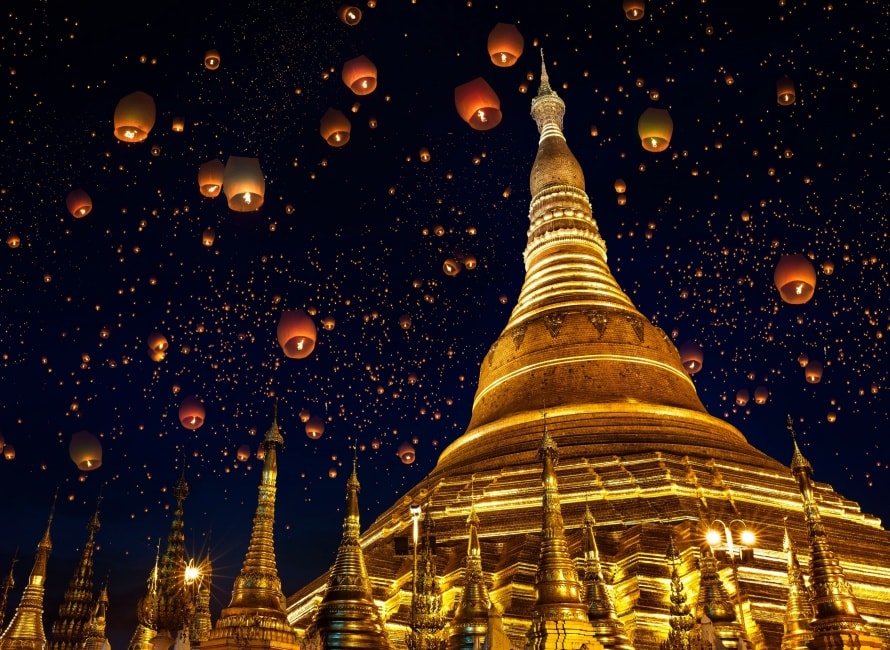
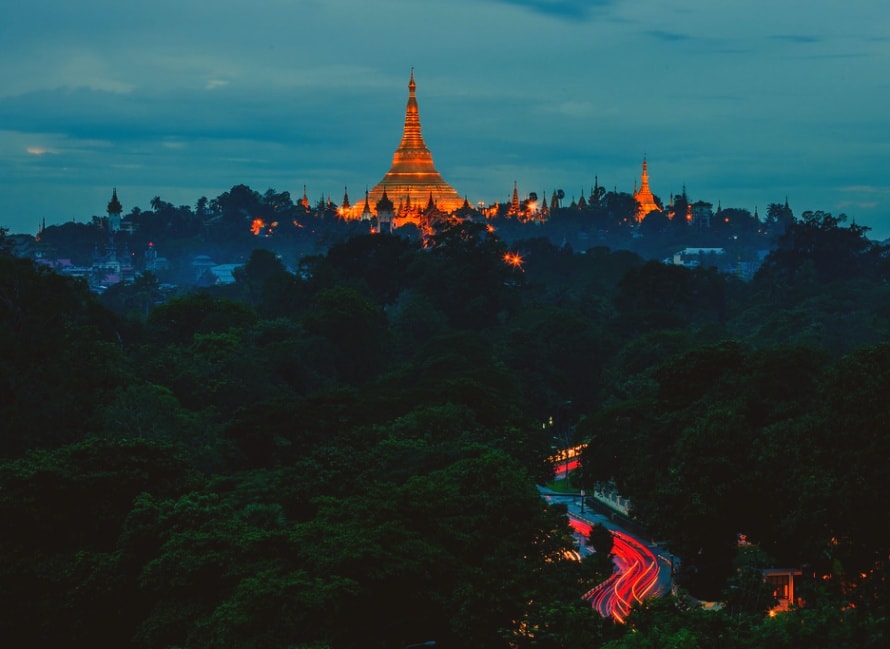
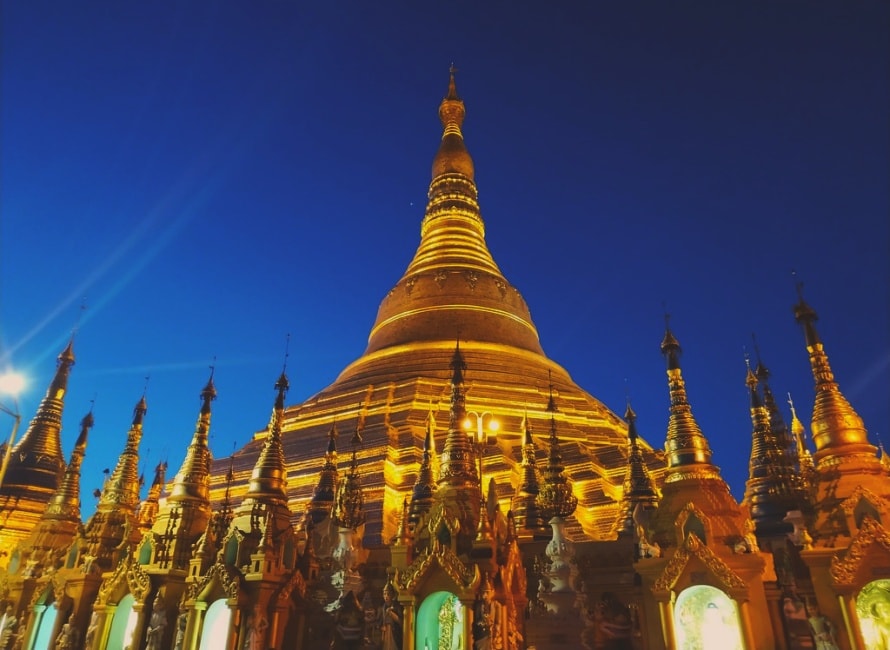
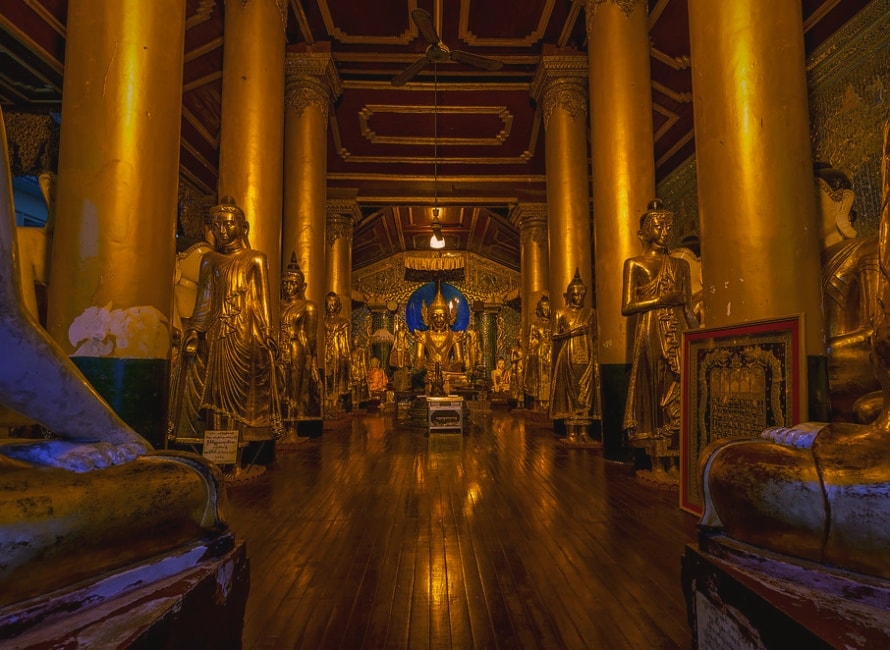
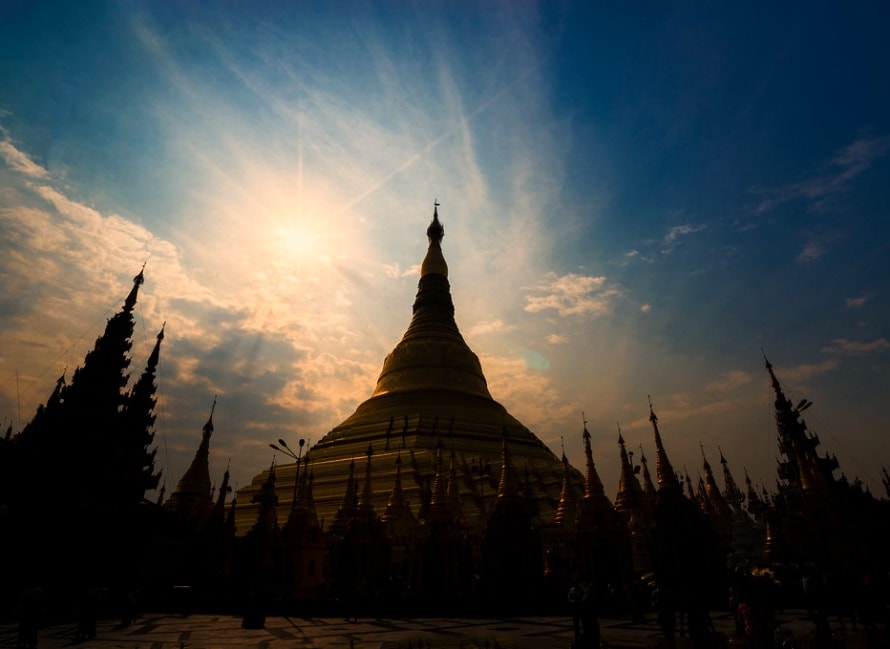

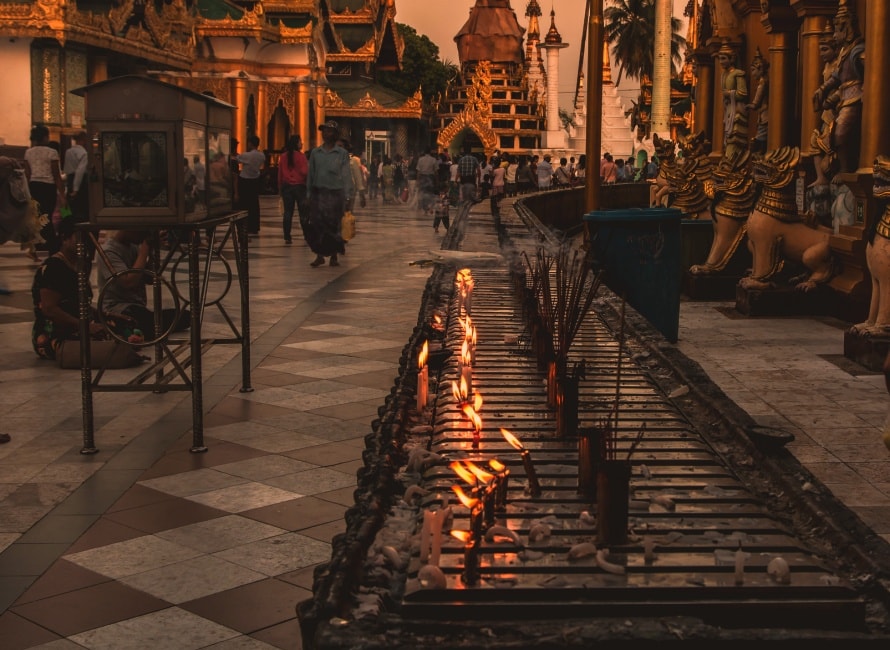
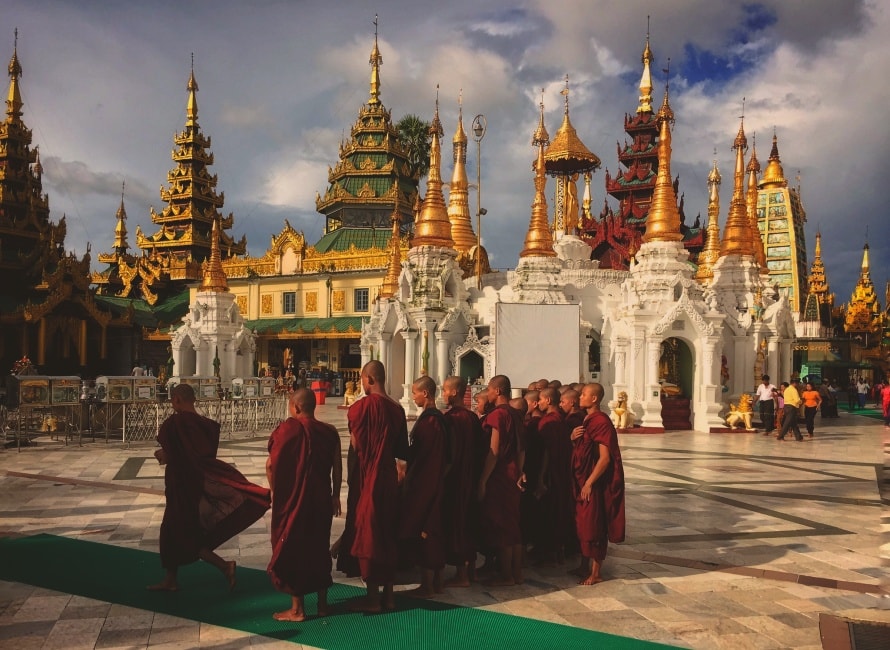
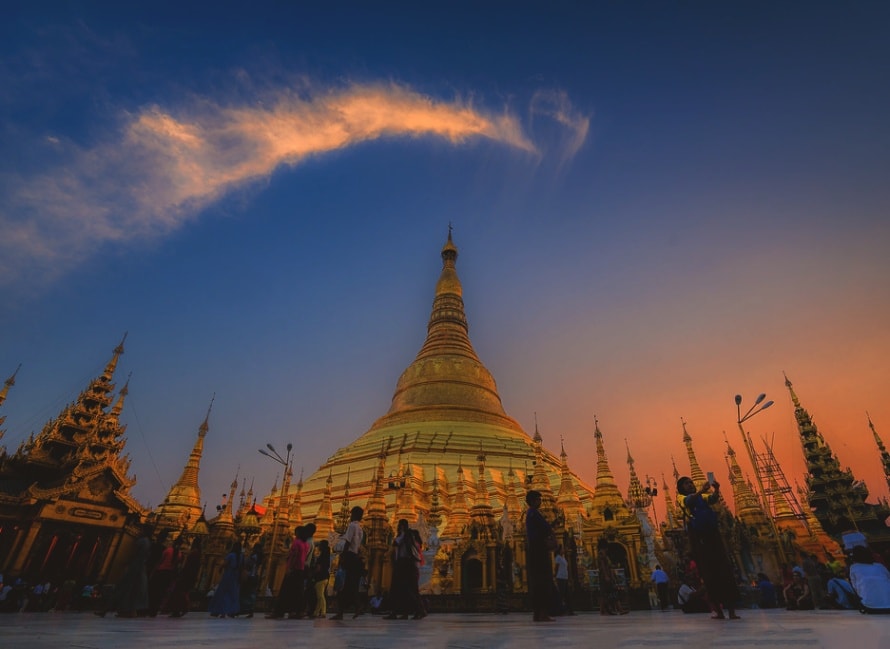
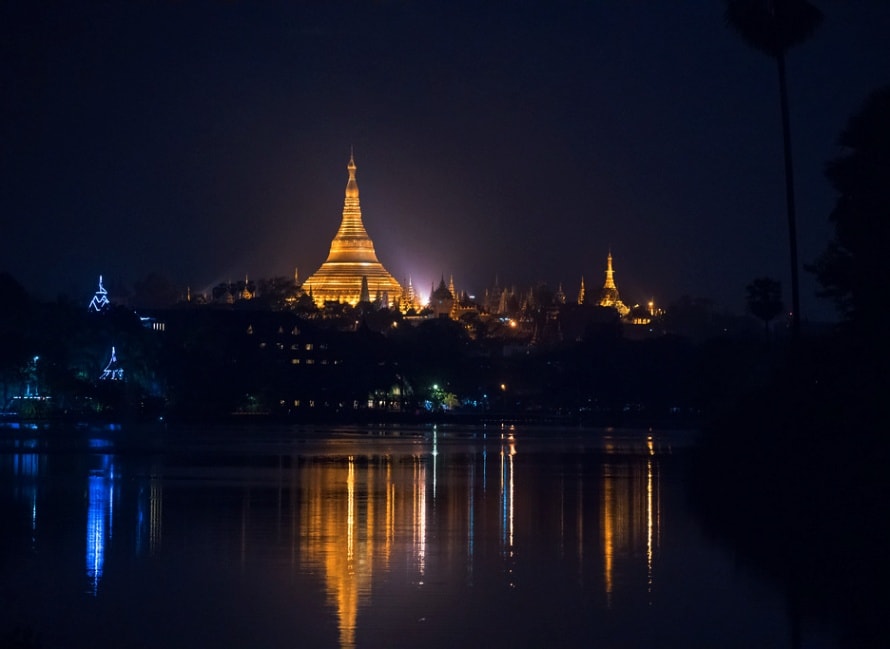
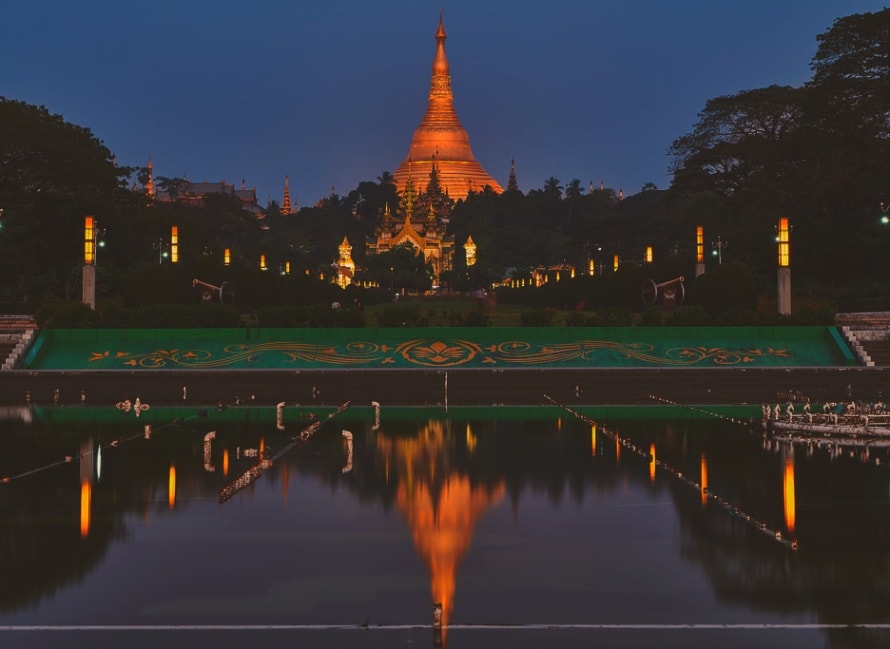
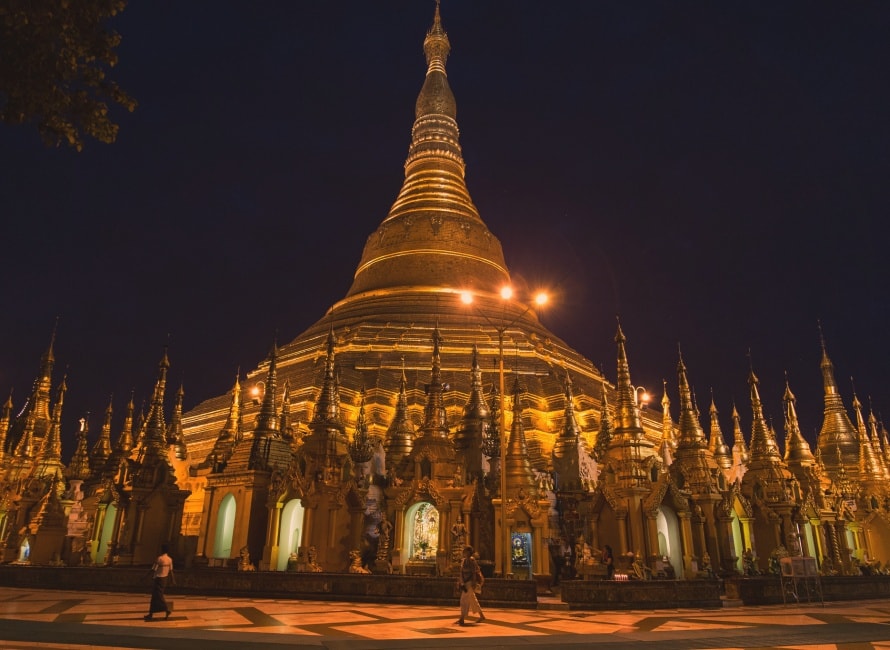
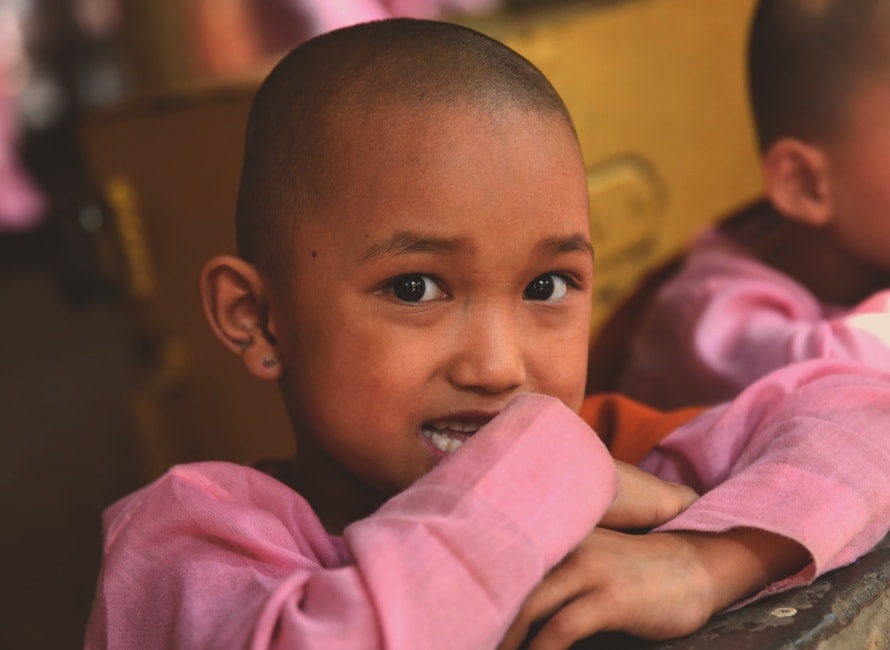






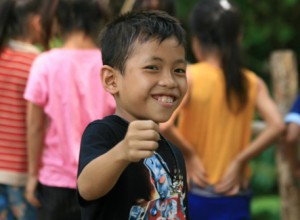













Jolie LIEMMy name is Jolie, I am a Vietnamese girl growing up in the countryside of Hai Duong, northern Vietnam. Since a little girl, I was always dreaming of exploring the far-away lands, the unseen beauty spots of the world. My dream has been growing bigger and bigger day after day, and I do not miss a chance to make it real. After graduating from the univesity of language in Hanoi, I started the exploration with a travel agency and learning more about travel, especially responsible travel. I love experiencing the different cultures of the different lands and sharing my dream with the whole world. Hope that you love it too!